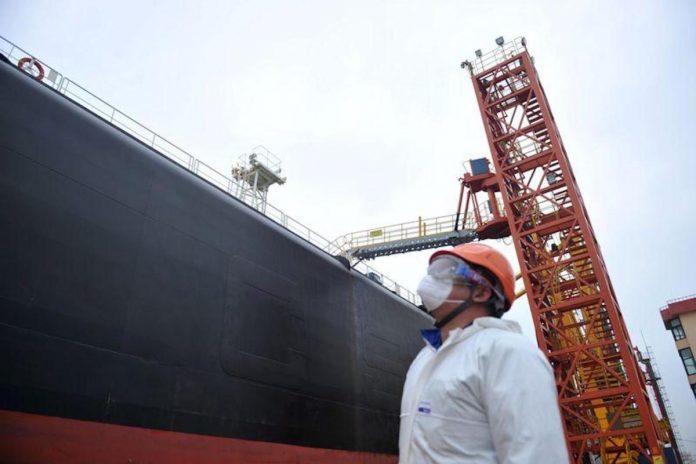China’s absence from the COP26 climate summit has drawn criticism from all corners.
Given President Xi Jinping’s lack of foreign travel since January 2020, his Glasgow no-show did not come as a surprise. China has already committed to achieving peak emissions before 2030 and carbon neutrality by 2060, so perhaps Beijing thought it had little more to offer at this stage.
However, as the world’s biggest carbon polluter, questions over how China aims to complete its climate commitments loom large.
China’s push toward carbon neutrality will have a major impact on the future structure of its energy sources. This in turn will eventually alter China’s relationship with Middle East countries that it has depended on for crude-oil supply for decades.
But carbon emissions from China’s oil use are dwarfed by the damage done from burning coal, and it is cutting out coal, not oil, that is Beijing’s immediate concern.
While the end game for everyone is renewable energy, in the shorter term, the phasing out of coal-fired power stations will lead to China buying more oil from Saudi Arabia and other countries in the Persian Gulf region. Contrary to what many at COP26 might say, the push for net-zero is likely to strengthen relations between Beijing and the Middle East based on the supply of oil.
China’s need for more oil to see it through this transition squares with Riyadh’s plans to maintain oil production while using methods like carbon capture and planting vast forests to reach net-zero carbon emissions. This approach has been labeled the “circular carbon economy,” and continuing to serve oil to its biggest customer China has been factored into the plan.
As China attempts to bring down coal consumption while maintaining its economic edge, its demand for Middle East oil is likely to increase rather than decrease in the foreseeable future.
China is already facing a major energy crisis. The ambitious aim for carbon neutrality by 2060 was made a little more than a year ago at the UN General Assembly. At this year’s event, China made a further pledge to stop building coal-fired power plants abroad.
But these noble aims have already contributed to a severe shortage of electricity in the country this year. Millions of homes and businesses were hit with power cuts after China imposed targets for energy consumption and energy intensity. The coal-fired power plants were the first to take the hit.
As winter approaches and more energy is needed, China has rushed to mine and burn more coal to ensure domestic consumption needs are met and to calm anger over power cuts. What it shows is that there is a limit to how quickly China can change its current energy-consumption structure. After all, Beijing has to rely on economic development and social stability for its legitimacy.
This experience was a reminder of just how much China relies on coal and why it remains China’s primary source of carbon emissions.
In 2019, fossil fuels made up 85% of China’s energy consumption, which is roughly the same as the rest of the world. But almost 58% came from coal – a figure far exceeding the global average of less than 30%. Consequently, burning coal amounts to about 80% of China’s total fossil-fuel emissions, followed by 14% from oil and 7% from natural gas. This highlights the challenge China faces in reducing coal consumption alone.
The focus on coal temporarily eases the immediate concern to cut oil consumption, although in the long term oil will face the same fate. According to the Low Carbon Economy Lab (LCEL) of Tsinghua University, coal has almost peaked in China and will plateau for about a decade before it begins to drop sharply.
Oil follows a similar graph to coal, but with additional, though limited, demand growth in the next decade, while natural gas has yet to hit its peak before it begins to decline.
Other studies and reports agree that China’s short-term imports of crude oil will continue to rise, with the majority coming from the Middle East. For example, an S&P Global report shows that China’s dependence on Middle Eastern oil rose in June despite the number of global crude-oil suppliers to China narrowing to 26, down from 41 in the same month of last year.
How much oil China buys from a country like Saudi Arabia will continue to depend on price rather than carbon-emission concerns for the foreseeable future.
One challenge to oil imports is China’s concern for energy security. China has been seeking new energy sources to reduce threats to its economic growth.
Beijing understands very well that carbon neutrality can only be achieved with a cleaner energy system. In this sense, China’s carbon-emission reduction is not only to combat climate change but also to reduce its over-reliance on external supplies. China is concerned that supplies could be cut at shipping chokepoints such as the Malacca Strait or the Strait of Hormuz during international disputes or conflicts.
Just like the developed countries, China’s dependence on crude-oil imports will fall, eventually. The Middle East’s oil producers will have to take that into consideration and consider a strategy of economic diversification in the long run. But in the meantime oil exports will continue to underpin China’s economic rise and define relations between Beijing and the Middle East.
By Yun Sun / Asia Times
The views and opinions expressed in this article are solely those of the author and do not necessarily reflect the position of AsiaWE Review.




